

Arken burst on to the scene with an extremely well thought through & executed ‘social first’ marketing campaign. Everywhere you looked there were Arken marketing affiliates and influencers gushing over Arken and its products.
I was sceptical at first, because at that point Vortex had been pivotal in driving down prices whilst simultaneously driving up innovation & value for money. I wasn't convinced that Arken could 'out-Vortex' Vortex themselves.
But, in the interests of continuing to test as many different scopes as I could possibly get my hands on – in the hopes that I didn’t miss any tricks – I purchased an EP-5 7-35x Gen. 2 with my own money and the intention of giving it a fair shake. I wanted to be beholden to no-one, so that I could produce an honest, no punches-pulled, review.

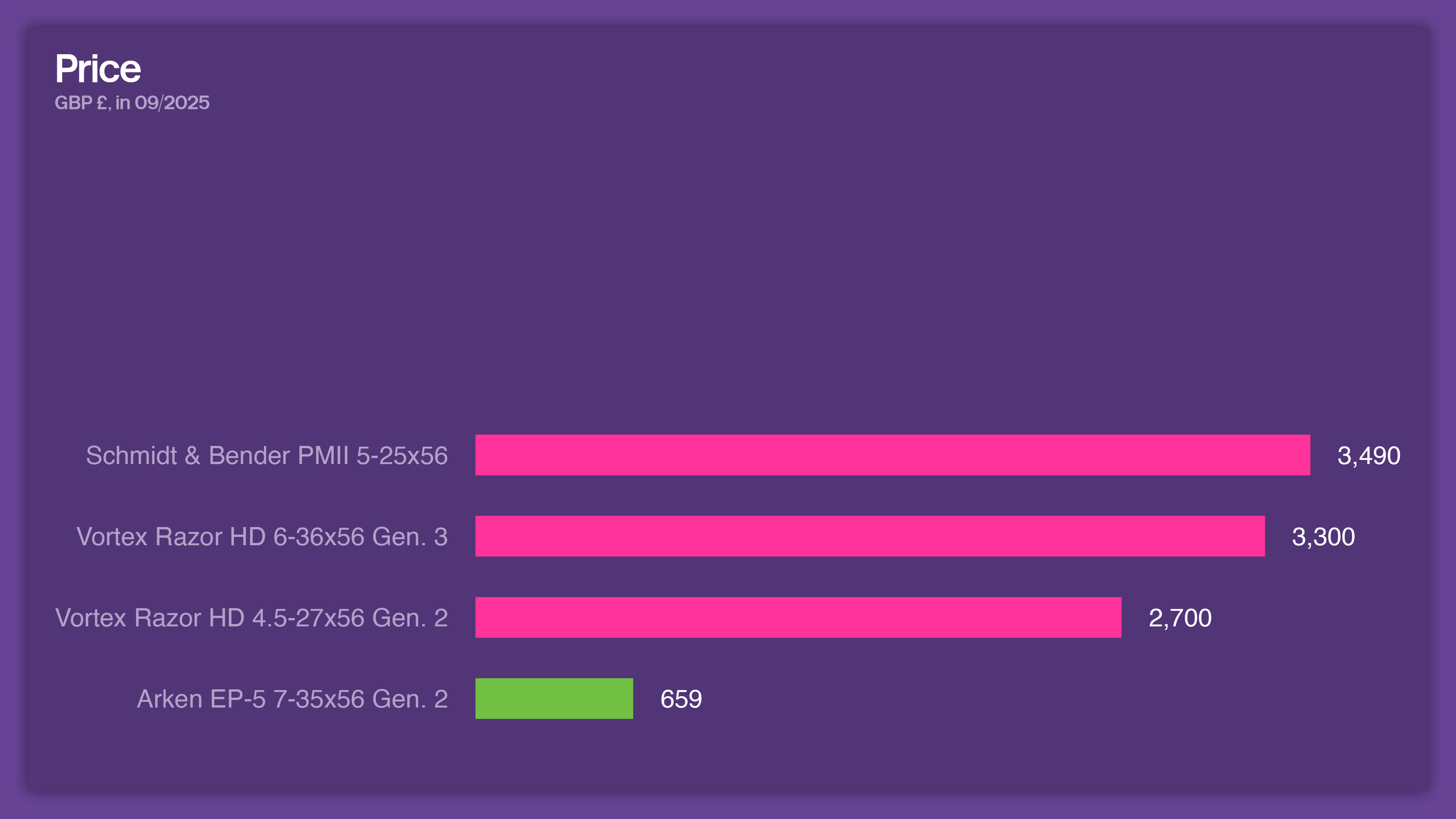
Existing reviews constantly refer to the Arken’s price tag. Some such reviews make some truly wild statements about what the Arken’s price tag should be.
To be fair to the other genuine reviewers, once you get your hands on the Arken it is impossible to do anything other than constantly wonder how Arken are able to produce such a high-quality scope and sell it at such an affordable price point. It doesn’t make any sense. At every touchpoint and during every test I was constantly bewildered by the Arken’s quality and performance - and its totally incongruous asking price.
I don’t want to state a price tag that the Arken should have, but instead I’ll compare its performance to some of the other scopes I have tested over the years and compare it with their price tags, so that you can make your own mind up.
The packaging that the Arken 7-35x arrives in is stylish & perfectly functional and it's custom cut foam liner does a good job of protecting the product on its long journey from the factory to your front door. But it doesn’t have the same sales floor impact as some of the big-ticket Zeiss, Vortex & Swarovski products. Having worked in packaging design for a good part of my career I know that marketing departments will often throw money at packaging when they know that their product is below par - in the hopes that the product will be perceived as super-premium on the sales floor (Scotch whisky brands are particularly guilty of this).
There are some brands of cartridge brass, for instance, where the manufacturer will spend more on the packaging than it cost to manufacture the brass itself.
For this reason I am often suspicious of products which are overly packaged & flashy. It’s reassuring to see that the Arken’s packaging is perfectly competent without being totally over the top, unlike some other manufacturers’ products. I have always respected Schmidt & Bender’s dialled-back packaging for this very reason. Their products do the talking.

The Arken EP-5 7-35x56 Gen. 2 is a variable magnification rifle scope with a side parallax adjuster and a reticle placed in the first focal plane (FFP). It benefits from matching angular units of measurement and turrets. It is built upon a 34mm main tube, and features a fully-multicoated Japanese glass package. It is available in MOA and MRAD variants.
The Arken is my kind of scope – a well executed ‘traditional’ design featuring the classic time-proven proportions that yield the light-path geometries which are most favourable to superlative optical performance. It's a handsome looking item.
You won’t find the Arken breaking from traditional, time-proven designs, in favour of presenting solutions to problems which never existed – so no mid-tube parallax collars (IOR) or double decker 12 o’clock turrets (Kahles K624i) here.
Where the Arken does break from the status quo, it does so in the service of a genuinely enhanced user experience – the innovative zero stop feature being the perfect example of this.
The Arken 7-35x's fit & finish is top notch. The magnification ring felt a little stiff in the hand, which is usually a good sign as it means that the erector tube, and the magnification cells within it, have been built within tight tolerances.
I opted for one of Arken’s modestly priced throw levers. Once mounted on a rifle the throw lever feels ‘just right’ and is very smooth in use.
The parallax adjuster which is located on the 9 o’clock turret is buttery smooth and it’s very easy to achieve a perfect sight picture. This is a breath of fresh air as many competing products cause you to endlessly try tweaking the parallax in an attempt to sharpen the sight picture up just a fraction more.

In terms of tactility, the Arken’s turrets are the best that I have ever experienced – at any price point.
If you told me that I would have to relegate the Tract Toric UHD’s turrets to second place I wouldn’t have believed you. I’d put the Swarovski X5i’s turrets in third place. The Swaro X5i has a £3,230 price tag. So make of that what you will. It’s so nice to see 10 MILs/25 MOAs per revolution compared to some scopes that have awkward numbers (Swaro X5i - 12.5 MOA per revolution). My 10 times table is pretty good, my 12.5 times table, not so much.
In addition to the tactility of the Arken’s turrets, it also has the most intuitive & effective zero stop mechanism that I have ever encountered. You don’t need any proprietary tools to set it (Swaro X5i) and you don’t lose any of your elevation adjustment if you choose to take advantage of the zero stop feature (Vortex Venom/Strike Eagle). Again, in this regard the Arken bests a £3,230 scope here.
On paper, the Arken’s 34mm main tube yields an impressive 110MOA/32 MILs of elevation adjustment. That’s enough to get you way out there with modern calibres. Those numbers aren’t a million miles away from the Vortex Razor HD 6-36x56 Gen. 3, which offers a class leading 120MOA/36MILs (£3,300).
The elevation turret on the Arken 7-35x features 100 clicks per rotation regardless of whether it is the MOA or MRAD version. This equates to 25MOA per revolution or 10MRAD per revolution.
The parallax dial on the Arken 7-35x is marked all the way down to 25yds.
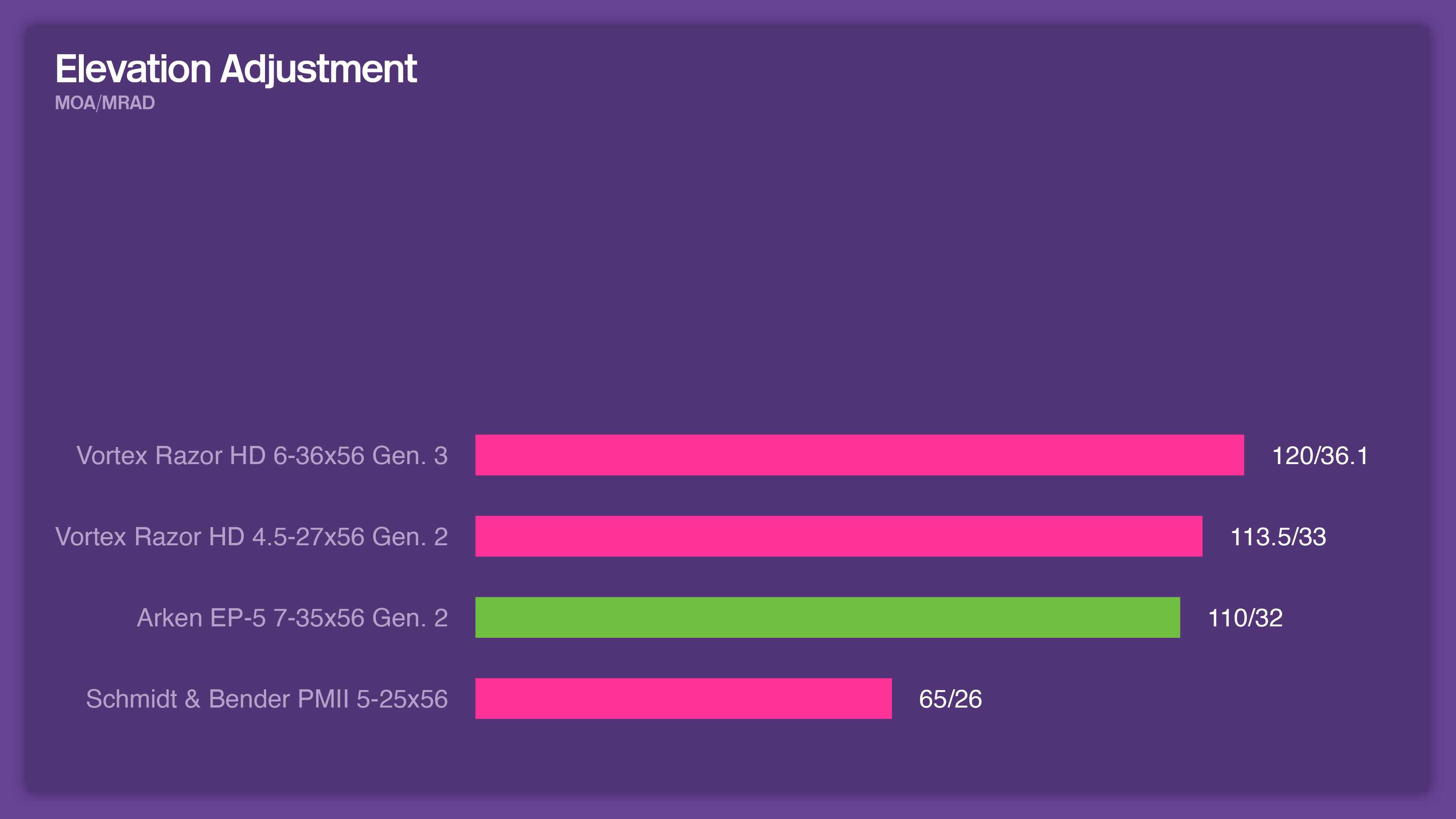
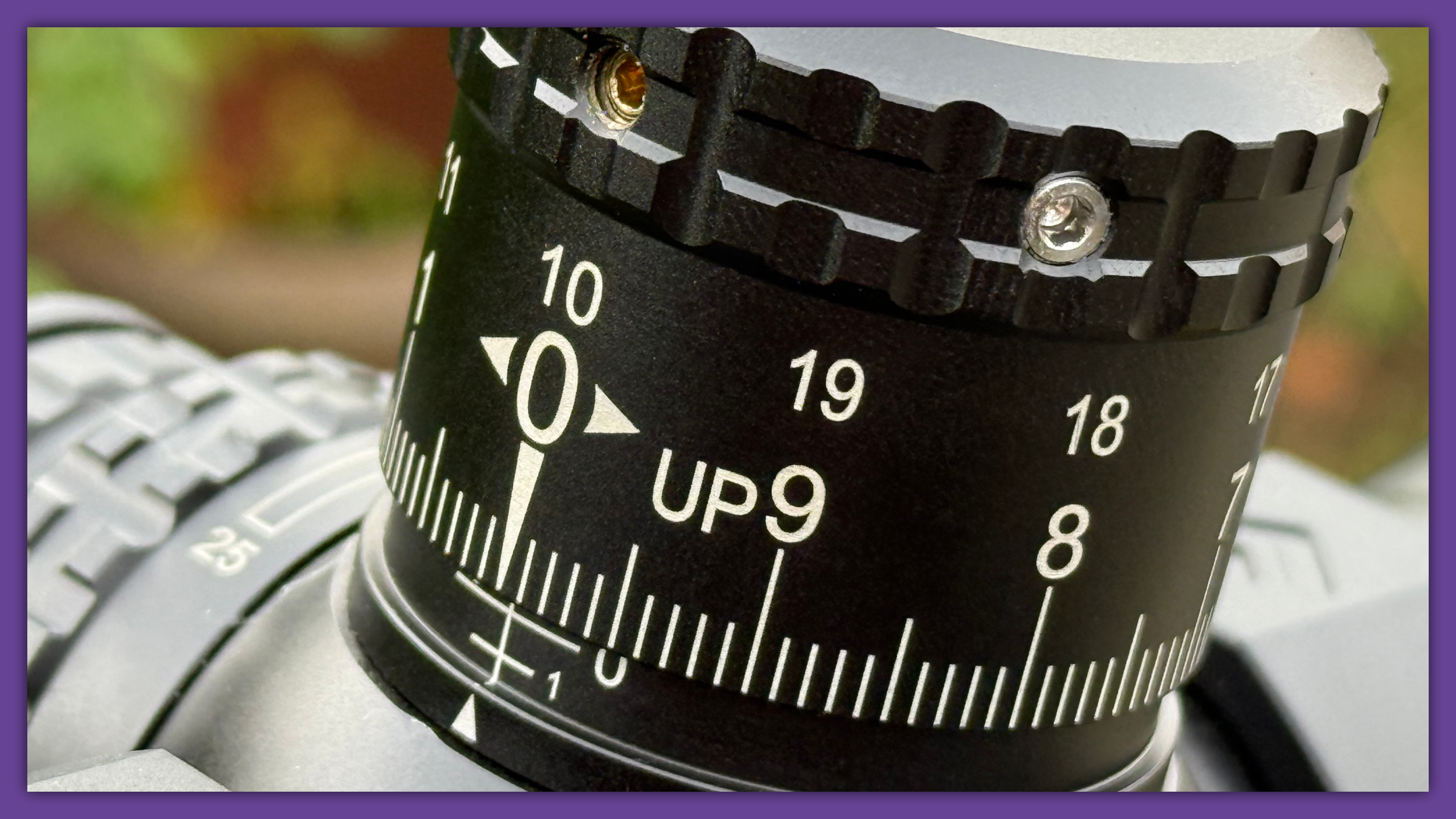
Controlling chromatic aberration (CA) is the foundation of any good optical prescription - fail to control CA and you’ll never be able to create a high-resolution, pin-sharp image. I have been testing scopes for decades now and I have become very good at forcing CA. A lot of the time I really have to go out of my way to force CA, and it’s unlikely that I’ll ever encounter these conditions in a real-life scenario.
Poorly corrected CA most often manifests itself as colour fringing on high contrast edges or a slightly 'soft' sight picture that you can never quite crisp-up with the parallax turret or ocular diopter. So if you ever find yourself trying to make micro-adjustments to the parallax adjuster in the hopes of crisping the image up just a tiny fraction more, and you can never quite find it, that can be a symptom of poorly controlled CA.
I’m pleased to say that the Arken 7-35x doesn’t have a fussy parallax adjuster and it’s effortless to focus it perfectly. And I mean perfectly.
There are a rarified few scopes that simply do not produce any CA whatsoever, no matter how hard you try to force it. These scopes tend to feature a fully apochromatically-corrected triplet objective lens group, and the engineering/design challenges involved in producing these scopes usually means an ultra-premium price tag compared to the easier & cheaper to produce (but less effective) achromatically-corrected doublet designs.
Over the years, there have only been four scopes that I have been unable to force any CA on – out of the hundreds that I have tested – these are: the Vortex Razor HD 4.5-27x Gen. 2 (£2,700); the Vortex Razor HD 6-36x Gen. 3 (£3,300); the Schmidt & Bender PMII 5-25x (£3,490); and the Swarovski Z6i 5-30x50 (£2,390).
I can now add a fifth scope to that super-exclusive club, as I found it impossible to force any CA whatsoever in the Arken 7-35x no matter how hard I tried. And I really tried as I couldn’t believe what I was seeing. So in this regard the Arken is up right there at the front of the pack with the PMII (£3,490). Compare the resulting optical resolution of the Arken 7-35x to the much lauded “PMII Killer”, the Kahles K624i, and the degree to which the Arken wipes the floor with the (£2,240) K624i is downright hilarious.
The Arken 7-35x was so good at controlling CA that I had to reach out to Arken to double check if the 7-35x was achromatically or apochromatically-corrected. Based on it's performance, it looked as though the Arken 7-35x was apochromatically corrected - but I didn't believe for a second that it could be at its price point. I was delighted when Arken came back confirming that the 7-35x is indeed apochromatically-corrected. This is the first fully-apochromatically corrected scope I have seen that is under £2,000.



In terms of contrast & colour temperature reproduction, it is common for manufacturers to use coatings which bump up the real-world contrast slightly so that the sight picture ‘pops’.
Whilst this is often received favourably by users – because what you are seeing through the scope is ‘even better than the real thing’ – any professional photographer or image retoucher will tell you that as soon as you artificially increase the contrast, saturation or vibrancy you start to lose some of the subtlety in the image. Enhancement and subtlety are opposite ends of the same see-saw, and you can’t get both ends up in the air at the same time.
If you are used to scopes which enhance the image like this, the Arken may very well appear ever so slightly washed-out to your eye. Whilst scopes which enhance the image in this way do make a better initial impression, I personally prefer a scope like the Arken 7-35x that reproduces the real-world faithfully, especially on longer range sessions. I have found that 'enhanced' scopes can become very tiring on the eye over time.
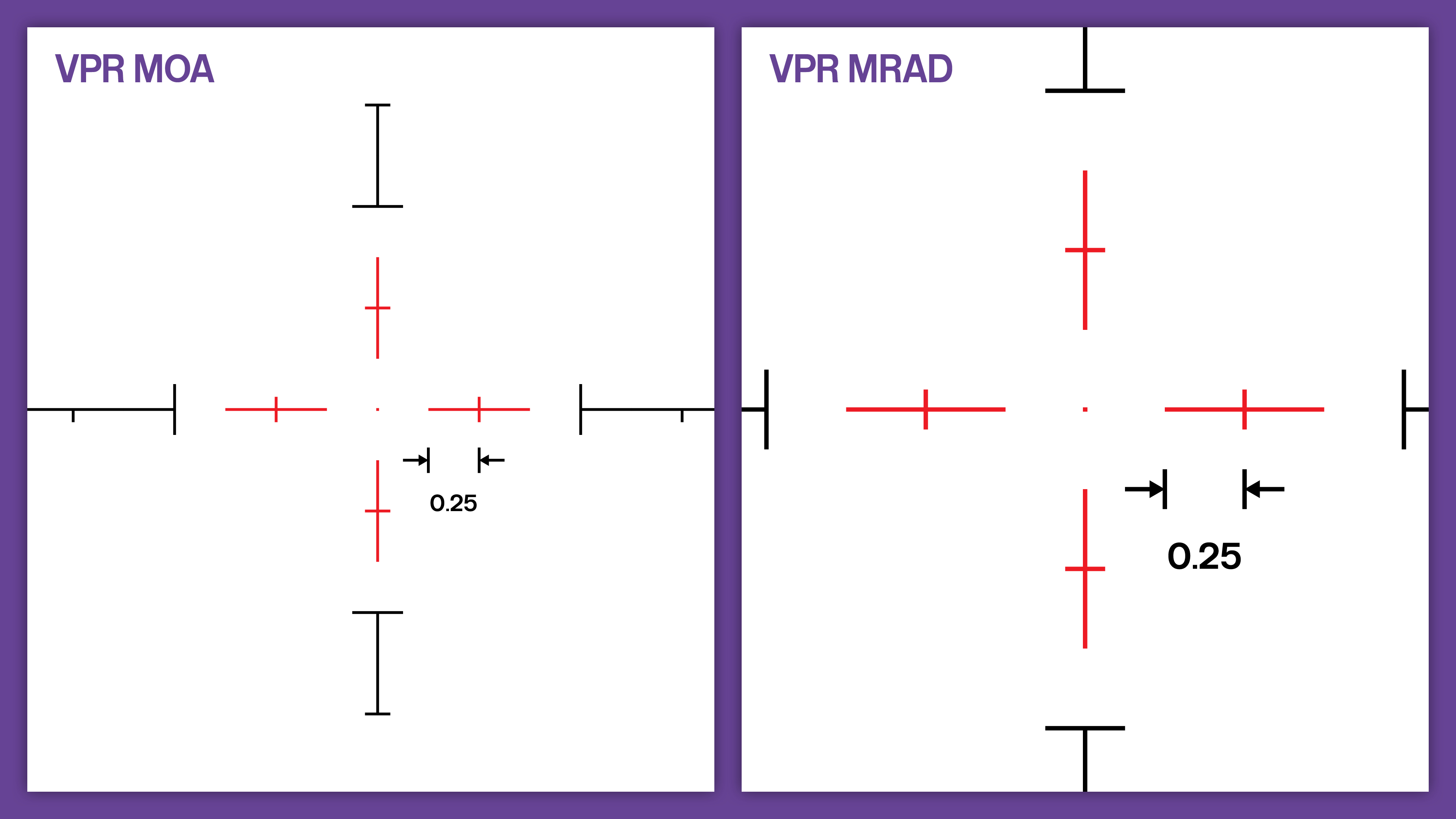
I have been a fan of Vortex’s EBR family of reticles for some time now, and I have spent a lot of time using the EBR-7 variations recently. Whilst I do love how much information is presented to the shooter I do think there is an argument that they might be guilty of information overload, and that their designs might benefit from being pared-down to some degree. Vortex’s most recent designs, the EBR-7D and the XLR-2, are moving in this streamlined direction.
To my mind, the VPR reticle in the Arken gets the balance between clarity & information presentation just right. I’ve only used the MIL version of the VPR to date, and I’d like to get my hands on a MOA version so that I can contrast & compare (there is of course the argument that MOA allows for finer adjustments). But I’m happy with either system and I like how streamlined the VPR reticle is. It’s a fine balance between being informative and providing so much information that the reticle starts to get in the way of your shooting – and I think Arken have judged this aspect of the VPR reticle very well indeed.
The weighting & scaling of the Arken 7-35x's reticle is also very well judged. It's often the case that manufacturers have to bump up the weighting of first focal plane (FFP) reticles in order to retain legibiliy at the lowest magnification, this can result in a overly heavy reticle when the scope is dialed up to full power (IOR Recon, £2,095). Clever design choices ensure that the Arken 7-35x's reticle is perfectly legible at the low end without becoming cumbersome at the high end. This isn't true of all FFP scopes. It's another detail that tells me that the Arken 7-35x's designers knew exactly what they were doing.
It's worth pointing out however, that in both the MOA and MRAD versions the centre section of the reticle (where I tend to spend 99.9% of my time) is divided into 0.25 chunks. This design lends itself more to MOA, were the turrets offer 0.25 unit adjustments. A 0.75 correction can therefore be achieved by applying three 0.25 clicks. In the MRAD version of the scope you can't dial 0.75 as the turrets have 0.1 click values - so you have to either make do with 0.7 or 0.8.
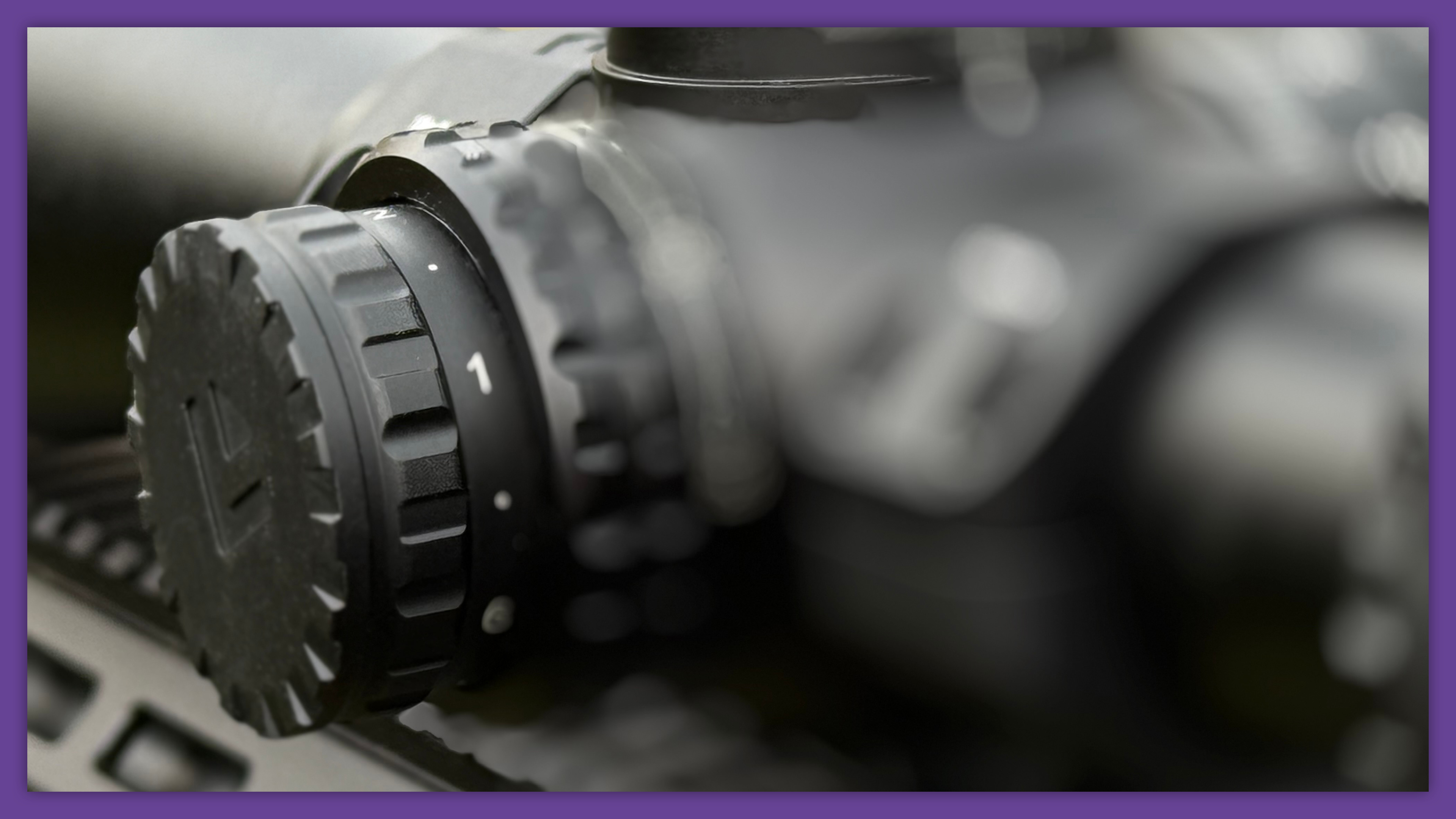
Reticle illumination is another subjective topic. I have seen some concerns raised online about the fact that only the centre, floating, cross hairs illuminate on the Arken 7-35x rather than the entire Christmas tree. This is largely down to subjective, personal, preference. Given the Arken’s hefty weight, I personally would only ever use it for target shooting and I can’t remember a single instance where I’ve shot a target in low light. So for me reticle illumination isn’t really an issue at all. But your mileage may vary.
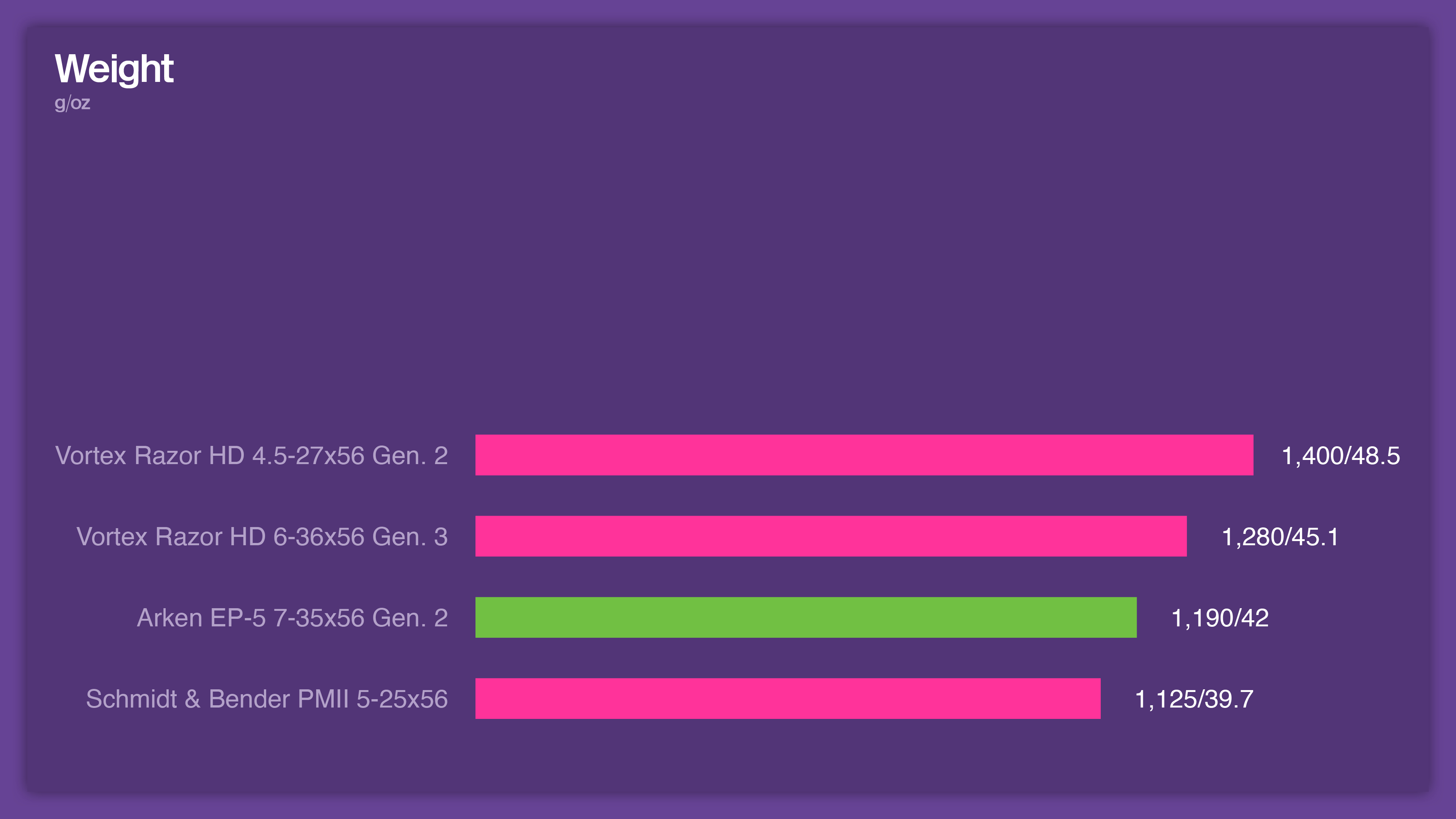
Talking of weight, at 1.2kg the Arken is a very heavy scope. This is an unavoidable characteristic of extremely low dispersion glass. It’s the glass’ density that largely dictates its refractive properties and the 56mm objective lens on the Arken is probably a similar weight to a similarly sized chunk of lead. All of the very best performing scopes are heavy in this way. Whilst this extra weight is a benefit to target shooters as it helps manage recoil better, it does make it unlikely that you will take an Arken 7-35x out stalking with you. But Arken do offer lightweight scopes such as the EP-L series which are more suited to such weight-sensitive applications. I’m hoping to get my hands on an EP-L at some point with a view to finding out if it would make a good walked-up stalking scope.
Some scopes, like Swarovski’s products have coatings which prioritize light transmission and contrast in extreme low light conditions. This means that the Swaro’s daylight performance is often compromised by using these coatings in this way – but to be honest I think you’ll struggle to find anyone who will turn their nose up at a Swaro’s optical performance in any conditions!
Arken’s choice of coatings on the 7-35x is very well considered, and the image quality produced by the fully-multicoated Japanese glass prescription is superlative in a variety of daylight-bright conditions.
One thing which is easier to quantify is eye-box freedom. The Arken 7-35x has an extremely tight eye-box, which can become very tiring during a longer session. Theoretically, tighter eye-boxes can yield less parallax error during shooting, as any deviation from optimum eye-alignment becomes immediately apparent to the user and forces them to make a correction. But I suspect most users will find the Arken’s eye-box tiring long before they start to appreciate the benefits of reduced parallax error.
In real-world usage I didn’t find the Arken’s eye-box too difficult to accommodate, but several other, very experienced, shooters struggled to get in behind it and they all commented on how frustratingly tight the Arken 7-35x’s eye-box was.
Something which the Arken 7-35x nails is the ocular adjuster which is lovely & smooth, and it doesn't suffer from any play whatsoever.
I had a Swarovski Z6i 5-30x50 BT Gen. 2, many years ago which had truly sublime glass, but which would produce two tiny groups sitting side-by-side. It took me a while to try and diagnose the problem (it's usually incorrectly torqued stock bolts), but a friend eventually pointed out that there was a little side-to-side wiggle in the Z6i's ocular adjuster, and because the Z6i was second focal plane (SFP) this had the effect of inducing something similar to parallax error.
There are no such concerns with the Arken 7-35x, and I am left wondering why it is that other manufacturers can't seem to achieve a similar build quality?
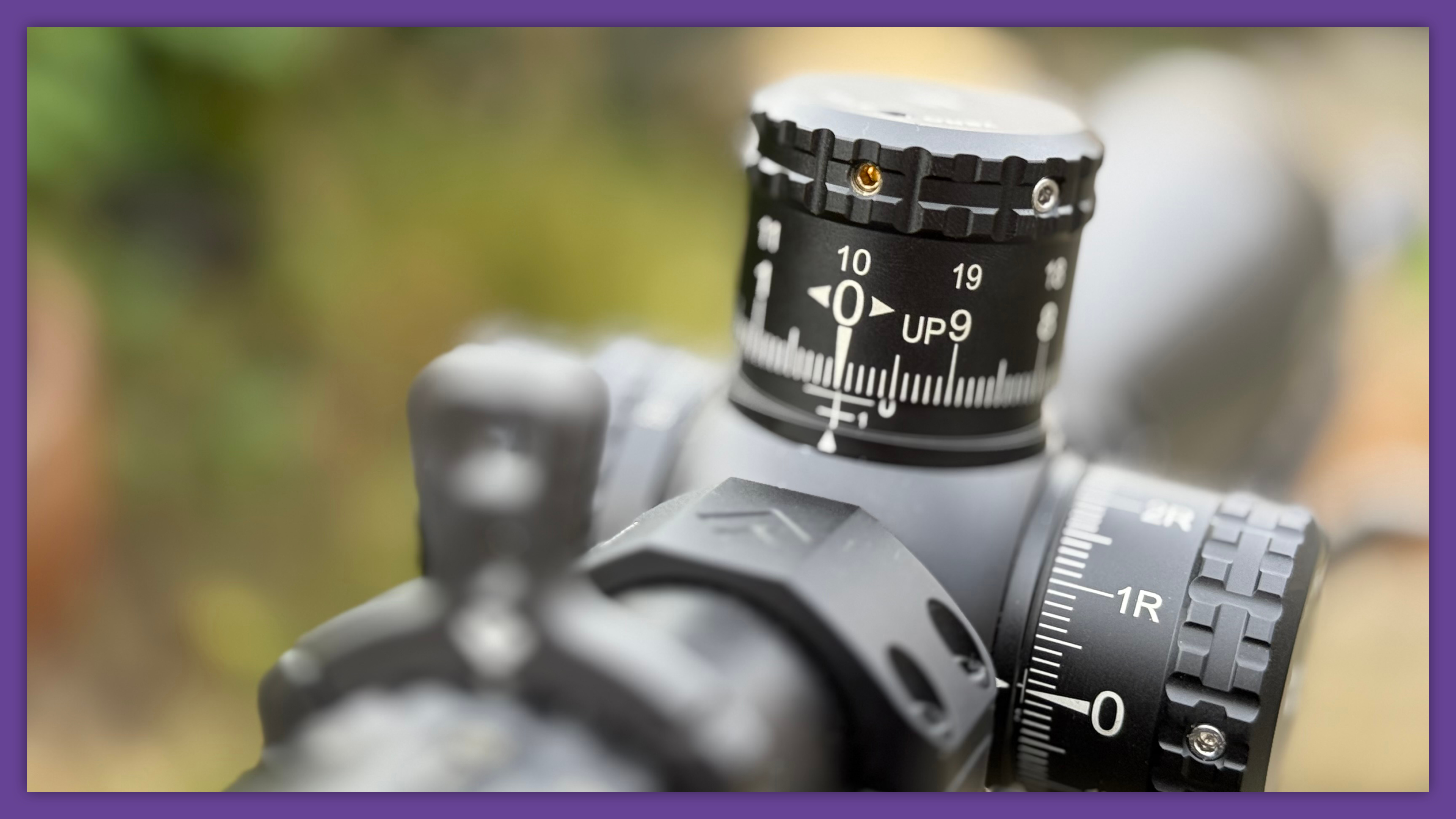
From what I’ve been able to ascertain so far, the Arken’s tracking is flawless. Time will tell – I prefer to run a scope for at least a year before coming to a conclusion about tracking – but my initial experience with the Arken is very confidence inspiring in this respect.
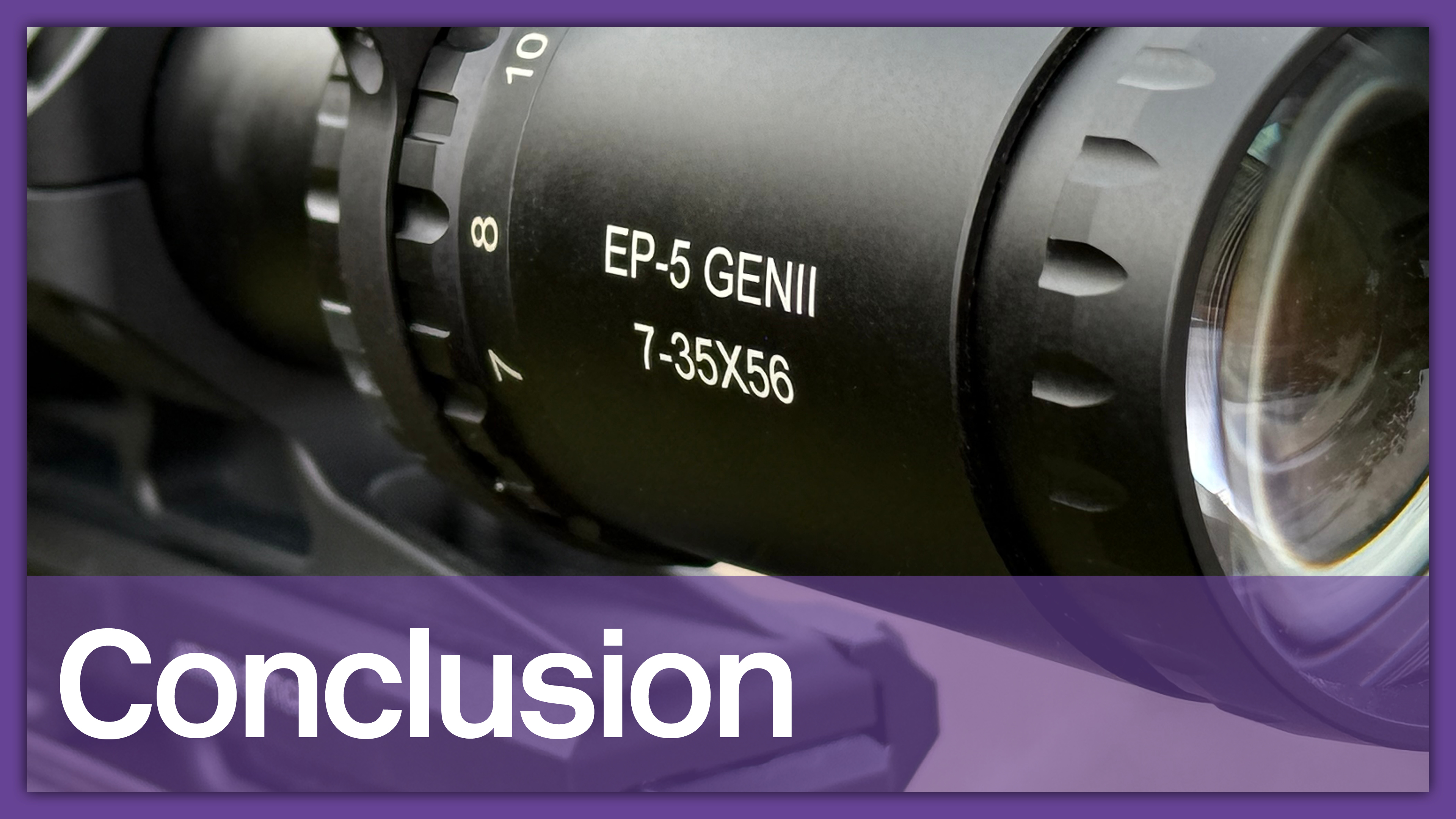
Having put the Arken 7-35x through its paces I totally get why all the reviewers say “it’s excellent for the money”. It is genuinely difficult not to become fixated by this scope’s price. However, that being said, such a conclusion misses the point somewhat.
The Arken 7-35x is an excellent scope. Period. If you look at Vortex’s current offerings (for no other reason than they are the biggest brand on the market right now, and they themselves have a reputation for providing excellent value for money), Vortex really don’t have anything that can compete with the Arken 7-35x until you get to the flagship Razor HD models, and those scopes start at £2,700 and go all the way up to £3,600. As good as the £1,100 Vortex Viper PST 5-25x50 Gen. 2 is (and it really is), the Arken 7-35x is better.
As I mentioned there have been other reviewers who have made some wild statements about what the Arken 7-35x’s price should be. All I’m going to say is that having looked at every single metric, there isn’t a single area where the Arken 7-35x isn’t competing with £2,000—£3,000 scopes and giving them a serious run for their money.
Show me an area where the Arken falls short of these Alpha scopes?
Perfect tracking. Fully apochromatically-corrected Japanese extra low dispersion glass. Perfect control of CA. Fully multicoated lenses. Jaw-dropping optical performance. First focal plane reticle. 110MOA/32MRAD of elevation adjustment. Ultra-reliable dialling turrets. The best zero-stop system on the market.
I have been lucky enough to own and use several Schmidt & Bender PMIIs, and both the Gen. 2 & Gen. 3 Vortex Razor HDs, as well as Swarovski X5s and Z6s. I have immensely enjoyed these fabulous scopes, but to my eye (your eye may differ) the Arken 7-35x is the single most importamt scope I have used to date. The fact that it has the price tag, that it has, is absolutely bonkers!